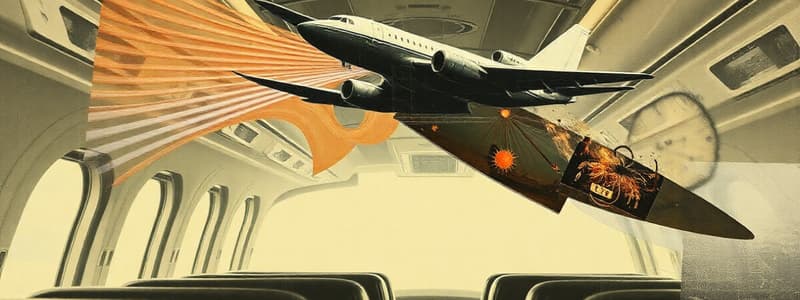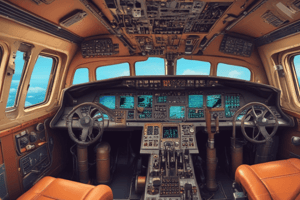Podcast
Questions and Answers
What happens to the oxygen masks when the cabin altitude reaches 14,000 feet?
What happens to the oxygen masks when the cabin altitude reaches 14,000 feet?
- Passengers must manually deploy them.
- The oxygen masks are automatically released. (correct)
- The outflow valves close.
- The flight crew is advised to wear them.
Why are positive pressure relief valves essential in an aircraft?
Why are positive pressure relief valves essential in an aircraft?
- To ensure the cabin air is properly conditioned.
- To prevent cabin altitude warnings.
- To prevent structural damage from excessive differential pressure. (correct)
- To regulate the temperature in the cabin.
What initiates the activation of protection functions in the aircraft?
What initiates the activation of protection functions in the aircraft?
- Routine maintenance checks.
- Excessive cabin altitude or pressure differences. (correct)
- Pilot discretion during flight.
- Normal air conditioning system operations.
At what point in the cabin altitude does the flight crew receive a warning to don oxygen masks?
At what point in the cabin altitude does the flight crew receive a warning to don oxygen masks?
What occurs when the differential pressure exceeds a maximum allowed value?
What occurs when the differential pressure exceeds a maximum allowed value?
What is the primary function of the outflow valves in an aircraft cabin?
What is the primary function of the outflow valves in an aircraft cabin?
What is the role of the safety valves also known as positive pressure relief valves?
What is the role of the safety valves also known as positive pressure relief valves?
How do equalization valves function when there is a small pressure difference?
How do equalization valves function when there is a small pressure difference?
What happens when the differential pressure exceeds the maximum allowed value?
What happens when the differential pressure exceeds the maximum allowed value?
In the event of a rapid pressure change, how do blow-out panels assist?
In the event of a rapid pressure change, how do blow-out panels assist?
Flashcards are hidden until you start studying
Study Notes
Cabin Pressurization Safety Features
- Aircraft protection function activation: Occurs when there is excessive cabin altitude, excessive differential pressure, or negative differential pressure.
- Cabin Altitude Warning System:
- Below 10,000 ft: Flight crew receives a warning to put on oxygen masks.
- At 14,000 ft: Oxygen masks are automatically released from the passenger cabin ceiling.
- At 15,000 ft: Outflow valves close automatically, independent of the normal control signal.
- Cabin Pressure Regulation:
- Constant airflow: The pressurized cabin receives constant airflow from the air conditioning system.
- Outflow valves: Limit the amount of air leaving the cabin, located on the aft fuselage or both aft and forward on some aircraft.
- Positive Pressure Relief Valves:
- Location: Typically found in the area of the aft pressure bulkhead.
- Function: Open against a spring when the differential pressure exceeds the maximum allowed value (around 8.5 psi, depending on aircraft type). Prevent structural damage.
- Equalization Valves:
- Location: Found in specific compartments to prevent damage to walls.
- Function: Spring-loaded flapper valves open when a small pressure difference exists.
- Blow-out Panels:
- Used for rapid pressure equalization in events like rapid decompression or explosions.
- Larger than equalization valves, allowing for quicker pressure release.
Cabin Pressurization System
- Cabin pressure is regulated by outflow valves, usually located on the aft fuselage or both aft and forward sections.
- Outflow valves limit the amount of air leaving the cabin.
- Increased differential pressure (cabin pressure minus ambient pressure) increases stress on the aircraft structure.
- To prevent structural damage, aircraft include safety valves (positive pressure relief valves).
- Safety valves open against a spring when differential pressure exceeds a maximum value, typically around 8.5 psi.
- Safety valves are often located near the aft pressure bulkhead, the point where the pressurized cabin meets the unpressurized tail section.
- Equalization valves are located in compartments to prevent damage to walls, they open when there is a small pressure difference.
- In case of rapid pressure changes, such as rapid decompression or explosions, equalization valves may be insufficient.
- Blow-out panels are installed to allow for pressure equalization during rapid pressure changes.
Studying That Suits You
Use AI to generate personalized quizzes and flashcards to suit your learning preferences.



